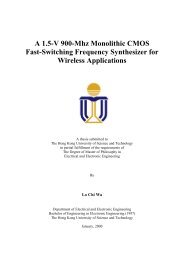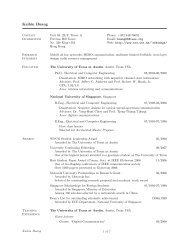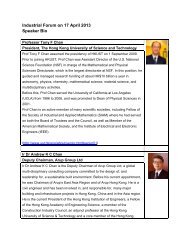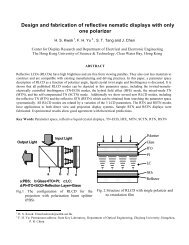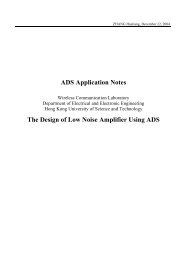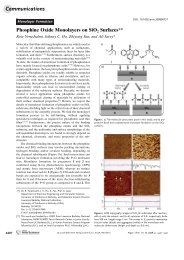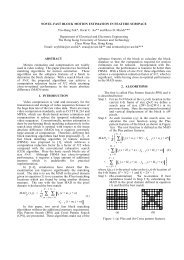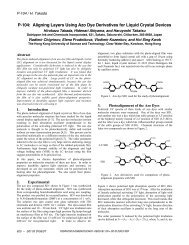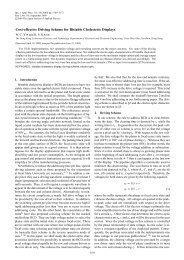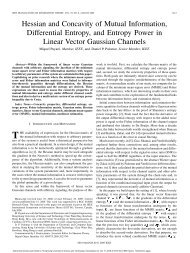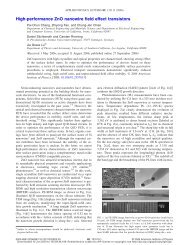Code Design for Radar STAP via Optimization Theory
Code Design for Radar STAP via Optimization Theory
Code Design for Radar STAP via Optimization Theory
Create successful ePaper yourself
Turn your PDF publications into a flip-book with our unique Google optimized e-Paper software.
DE MAIO et al.: CODE DESIGN FOR RADAR <strong>STAP</strong> VIA OPTIMIZATION THEORY 693[13] M. Bell, “In<strong>for</strong>mation theory of radar and sonar wave<strong>for</strong>ms,” in WileyEncyclopedia of Electrical and Electronic Engineering, J. G. Webster,Ed. New York: Wiley-Interscience, 1999, vol. 10, pp. 180–190.[14] A. Leshem, O. Naparstek, and A. Nehorai, “In<strong>for</strong>mation theoric adaptiveradar wave<strong>for</strong>m design <strong>for</strong> multiple extended targets,” IEEE J. Sel.Topics Signal Process., vol. 1, no. 1, pp. 42–55, Jun. 2007.[15] A. De Maio, S. De Nicola, Y. Huang, S. Zhang, and A. Farina, “<strong>Code</strong>design to optimize radar detection per<strong>for</strong>mance under accuracy andsimilarity constraints,” IEEE Trans. Signal Process., vol. 56, no. 11,pp. 5618–5629, Nov. 2008.[16] S. Boyd and L. Vandenberghe, Convex <strong>Optimization</strong>. Cambridge,U.K.: Cambridge Univ. Press, 2003.[17] A. Nemirovski, “Lectures on modern convex optimization,” GeorgiaInstit. of Technology, Atlanta, GA, Fall, 2005, class notes.[18] A. De Maio, S. De Nicola, Y. Huang, Z.-Q. Luo, and S. Zhang, “<strong>Design</strong>of phase codes <strong>for</strong> radar per<strong>for</strong>mance optimization with a similarityconstraint,” IEEE Trans. Signal Process., vol. 57, no. 2, pp. 610–621,Feb. 2009.[19] A. d’Aspermont and S. Boyd, “Relaxations and randomized methods<strong>for</strong> nonconvex QCQPs,” Stan<strong>for</strong>d Univ., Stan<strong>for</strong>d, CA, Autumn, 2003,EE392o class notes,.[20] W.-K. Ma, T. N. Davidson, K. M. Wong, Z.-Q. Luo, and P.-C. Ching,“Quasi-maximum-likelihood multiuser detection using semi-definiterelaxation with application to synchronous CDMA,” IEEE Trans.Signal Process., vol. 50, no. 4, pp. 912–922, Apr. 2002.[21] A. Mobasher, M. Taherzadeh, R. Sotirov, and A. K. Khandani, “A nearmaximum-likelihooddecoding algorithm <strong>for</strong> MIMO systems based onsemi-definite programming,” IEEE Trans. Inf. <strong>Theory</strong>, vol. 53, no. 11,pp. 3869–3886, Nov. 2007.[22] E. Karipidis, N. D. Sidiropoulos, and Z.-Q. Luo, “Quality of service andmax-min fair transmit beam<strong>for</strong>ming to multiple cochannel multicastgroups,” IEEE Trans. Signal Process., vol. 56, no. 3, pp. 1268–1279,Mar. 2008.[23] J. Ward, “Space-time adaptive processing <strong>for</strong> airborne radar,” LincolnLabs., MIT, Lexington, MA, Tech. Rep. 1015, Dec. 1994.[24] R. Klemm, Principles of Space-Time Adaptive Processing. London,U.K.: IEE Press, 2002.[25] J. R. Guerci, Space-Time Adaptive Processing <strong>for</strong> <strong>Radar</strong>. Norwood,MA: Artech House, 2003.[26] Y. Huang and S. Zhang, “Complex matrix decomposition and quadraticprogramming,” Math. Oper. Res., vol. 32, no. 3, pp. 758–768, Aug.2007.[27] W. Ai, Y. Huang, and S. Zhang, “Further results on rank-one matrixdecomposition and its applications,” Math. Programm., Jan. 2008, accepted<strong>for</strong> publication.[28] J. S. Bergin and P. M. Techau, “High-fidelity site-specific radar simulation:KASSPER ’02 workshop datacube,” in ISL Technical Note,ISL-SCRD-TR-02-105, Vienna, VA, May 2002.[29] R. A. Horn and C. R. Johnson, Matrix Analysis. Cambridge, U.K.:Cambridge Univ. Press, 1985.[30] H. L. Van Trees, Optimum Array Processing. Part IV of Detection, Estimationand Modulation <strong>Theory</strong>. New York: Wiley, 2002.[31] P. Antonik, M. C. Wicks, H. D. Griffiths, and C. J. Baker, “Frequencydiverse array radars,” in Proc. 2006 IEEE Int. <strong>Radar</strong> Conf., Verona, NY,Apr. 24–27, 2006, pp. 215–217.[32] P. Antonik, M. C. Wicks, H. D. Griffiths, and C. J. Baker, “Multi-missionmulti-mode wave<strong>for</strong>m diversity,” in Proc. 2006 IEEE Int. <strong>Radar</strong>Conf., Verona, NY, Apr. 24–27, 2006, pp. 580–582.[33] J. S. Goldstein, I. S. Reed, and P. A. Zulch, “Multistage partially adaptive<strong>STAP</strong> CFAR detection algorithm,” IEEE Trans. Aerosp. Electron.Syst., vol. 35, no. 2, pp. 645–661, Apr. 1999.[34] L. Bomer and M. Antweiler, “Polyphase Barker sequences,” Electron.Lett., vol. 25, no. 23, pp. 1577–1579, Nov. 1989.[35] M. Friese, “Polyphase Barker sequences up to length 36,” IEEE Trans.Inf. <strong>Theory</strong>, vol. 42, no. 4, pp. 1248–1250, Jul. 1996.[36] J. F. Sturm, “Using SeDuMi 1.02, a MATLAB toolbox <strong>for</strong> optimizationover symmetric cones,” Optim. Methods Softw., vol. 11–12, pp.625–653, Aug. 1999.[37] E. Mozeson and N. Levanon, “MATLAB code <strong>for</strong> plotting ambiguityfunctions,” IEEE Trans. Aerosp. Electron. Syst., vol. 38, no. 3, pp.1064–1068, Jul. 2002.[38] A. De Maio and M. Lops, “<strong>Design</strong> principles of MIMO radar detectors,”IEEE Trans. Aerosp. Electron. Syst., vol. 43, no. 3, pp. 886–898,Jul. 2007.[39] Y. Yang and R. S. Blum, “Minimax robust MIMO radar wave<strong>for</strong>m design,”IEEE J. Sel. Topics Signal Process., vol. 1, no. 1, pp. 42–55, Jun.2007.[40] J. Li and P. Stoica, MIMO <strong>Radar</strong> Signal Processing. New York:Wiley, 2009.[41] R. E. Blahut, W. M. Miller, and C. H. Wilcox, <strong>Radar</strong> and Sonar. NewYork: Springer-Verlag, 1991, pt. 1, reprint.Antonio De Maio (S’01–AM’02–M’03–SM’07)was born in Sorrento, Italy, on June 20, 1974. Hereceived the Dr.Eng. degree (with honors) and thePh.D. degree in in<strong>for</strong>mation engineering, both fromthe University of Naples Federico II, Naples, Italy,in 1998 and 2002, respectively.From October to December 2004, he was a visitingresearcher at the U.S. Air Force Research Laboratory,Rome, NY. From November to December 2007, hewas a visiting researcher at the Chinese Universityof Hong Kong, Hong Kong. Currently, he is an AssociateProfessor at the University of Naples Federico II. His research interestlies in the field of statistical signal processing, with emphasis on radar detection,convex optimization applied to radar signal processing, and multiple-accesscommunications.Silvio De Nicola (S’07) received the Dr. Eng.degree (summa cum laude) in telecommunicationengineering from the University of Naples FedericoII, Italy, in 2004. He is currently working towardsthe Ph.D. degree in in<strong>for</strong>mation and telecommunicationengineering at the Department of Electronicand Telecommunication Engineering in the sameuniversity.Until 2006, he worked as consultant in TelecomItaly. In 2007, he was a visiting student at the ChineseUniversity of Hong Kong. He works <strong>for</strong> the Italianregulatory authority in the communications sector (AGCOM). His research interestlies in optimization theory, with emphasis on radar signal processing.Yongwei Huang (M’09) received the B.Sc. degree incomputational mathematics and M.Sc. degree in operationsresearch , both from Chongqing University,in 1998 and 2000, respectively, and the Ph.D. degreein operations research from the Chinese University ofHong Kong in 2005.He was a Postdoctoral Fellow at the Departmentof Systems Engineering and Engineering Management,the Chinese University of Hong Kong, and avisiting researcher of the Department of Biomedical,Electronic, and Telecommunication Engineeringat the University of Napoli “Federico II,” Italy. Currently, he is a ResearchAssociate at the Department of Electronic and Computer Engineering, theHong Kong University of Science and Technology. His research interests arerelated to optimization theory and algorithms, including conic optimization,robust optimization, combinatorial optimization, and stochastic optimization,and their applications in signal processing, radar, and wireless communications.Daniel P. Palomar (S’99–M’03–SM’08) receivedthe Electrical Engineering and Ph.D. degrees (bothwith honors) from the Technical University of Catalonia(UPC), Barcelona, Spain, in 1998 and 2003,respectively.Since 2006, he has been an Assistant Professorin the Department of Electronic and ComputerEngineering at the Hong Kong University of Scienceand Technology (HKUST), Hong Kong. He has heldseveral research appointments, namely, at King’sCollege London (KCL), London, U.K.; TechnicalUniversity of Catalonia (UPC), Barcelona, Spain; Stan<strong>for</strong>d University, Stan<strong>for</strong>d,CA; Telecommunications Technological Center of Catalonia (CTTC),Barcelona, Spain; Royal Institute of Technology (KTH), Stockholm, Sweden;University of Rome “La Sapienza,” Rome, Italy; and Princeton University,Princeton, NJ. His current research interests include applications of convex




